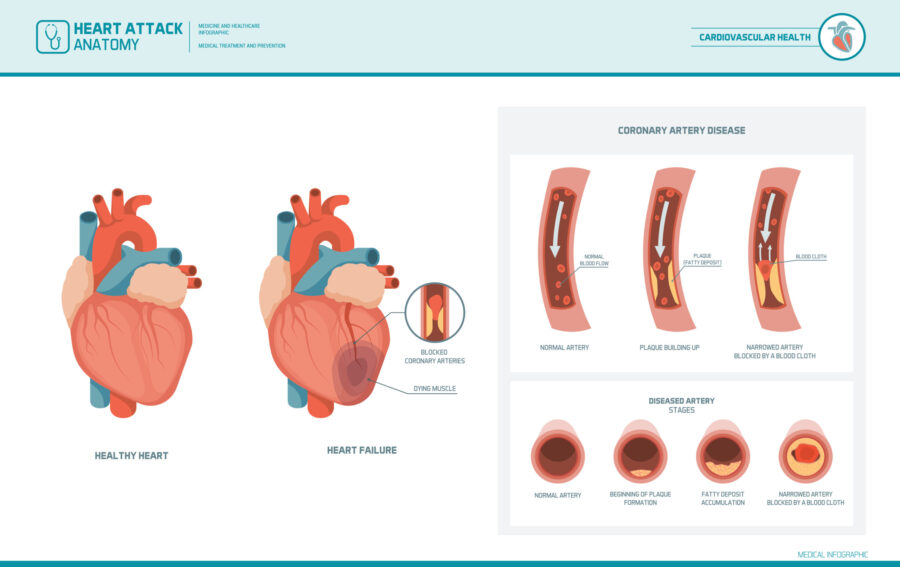Coronary Artery Disease: A Deep Dive into Causes and Treatments
Coronary Artery Disease (CAD) is one of the leading causes of death worldwide. It’s a condition characterized by the accumulation of plaque in the coronary arteries, leading to reduced blood flow to the heart. This article aims to provide an in-depth understanding of CAD, including its causes, prevention, and treatment options.
Understanding Coronary Artery Disease
Coronary Artery Disease develops when cholesterol and other substances in your blood form plaques on the inner walls of the coronary arteries, narrowing them and restricting blood flow to the heart. This can lead to angina (chest pain) or a heart attack.
Causes and Risk Factors
Several factors contribute to the development of CAD:
- High cholesterol: Elevated levels of low-density lipoprotein (LDL) cholesterol can lead to plaque buildup.
- High blood pressure: This can damage arteries, making them more susceptible to narrowing.
- Smoking: This can damage blood vessels and reduce the amount of oxygen in the blood.
- Diabetes: High blood sugar levels can damage blood vessels.
- Family history of CAD: Genetics plays a significant role in the development of CAD.
Prevention Strategies
Coronary Artery Disease is a condition that can be prevented or managed with lifestyle modifications:
- Healthy diet: Consuming a diet low in saturated fats, cholesterol, and sodium can help manage CAD.
- Regular exercise: Regular physical activity can strengthen the heart and improve blood circulation.
- Maintaining a healthy weight: Excess weight contributes to high cholesterol and high blood pressure.
- Avoiding tobacco: Smoking or using other tobacco products can damage your blood vessels.
- Managing stress: High levels of stress can increase your risk of CAD.
Treatment Approaches
Depending on the severity, CAD can be managed through medication, non-surgical procedures, and surgical interventions:
- Medication: This can include drugs to lower blood pressure, reduce cholesterol, and prevent blood clots.
- Non-surgical procedures: Procedures like angioplasty and stenting can be used to open narrowed or blocked coronary arteries.
- Surgical interventions: Coronary artery bypass surgery might be recommended in severe cases to improve blood flow to the heart.
Recognizing the Symptoms
Recognizing the symptoms of CAD is crucial for timely intervention. Common symptoms include:
- Angina: This is characterized by chest pain or discomfort, often described as pressure or a squeezing sensation in the chest.
- Shortness of breath: If the heart cannot pump enough blood to meet the body’s needs, it may result in breathlessness.
- Fatigue: Individuals might feel unusually tired due to the heart’s reduced ability to pump blood.
Diagnostics
Healthcare providers use several tests to diagnose CAD:
- Electrocardiogram (ECG): Measures electrical activity in the heart and can detect a previous or ongoing heart attack.
- Stress Test: Helps to identify blockages in coronary arteries by monitoring the heart’s response to exercise.
- Echocardiogram: Uses sound waves to create a picture of the heart, showing how well it’s functioning.
- Coronary angiogram: Involves the use of dye and X-ray images to visualize the inner lining of the coronary arteries.
Associated Conditions
The impact of CAD often extends beyond the heart, leading to several associated conditions:
- Heart Failure: If CAD results in heart muscle damage, the heart may become too weak to pump blood efficiently, leading to heart failure.
- Arrhythmia: CAD can disrupt the heart’s electrical pathways, leading to abnormal heart rhythms or arrhythmias.
- Peripheral artery disease: Similar plaque buildup can occur in the arteries supplying blood to the limbs, leading to peripheral artery disease.
- Kidney disease: Insufficient blood supply due to narrowed arteries can also affect the kidneys, leading to kidney disease.
CAD’s Impact on Life
Living with CAD requires certain adjustments to maintain heart health and prevent the worsening of the disease. Regular physical activity, a balanced diet, and proper stress management techniques are essential. Regular health check-ups and medication adherence are also crucial.
In addition to these lifestyle adjustments, mental health should not be overlooked. Individuals with CAD might experience stress, anxiety, or depression. Mental health professionals can provide the necessary support and techniques to cope with these challenges.
The Importance of Follow-Up Care
CAD is a chronic condition that requires long-term management. Regular follow-up care is crucial to monitor the progression of the disease, adjust treatment plans, and address any new symptoms or concerns. Follow-up appointments often involve physical exams, discussions about lifestyle and medication adjustments, and sometimes further diagnostic tests.
Importance of Public Awareness and Education
Public education about CAD is critical to prevent the onset and progression of the disease. Increased awareness can help people recognize the early signs of CAD and seek medical attention promptly, possibly preventing severe consequences such as heart attacks.
Education initiatives should focus on promoting heart-healthy lifestyle choices, such as maintaining a balanced diet, engaging in regular physical activity, refraining from tobacco use, and effectively managing stress. These preventive measures, if widely adopted, can significantly reduce the burden of CAD in the population.
Role of Healthcare Providers
Healthcare providers play a crucial role in managing CAD. They are responsible for diagnosing the condition, determining its severity, and developing a comprehensive treatment plan. They also play an instrumental role in patient education, helping patients understand their condition, medication, lifestyle modifications, and the importance of follow-up care.
Furthermore, healthcare providers should collaborate with patients to manage CAD effectively. This includes regular monitoring of the patient’s condition, adjusting treatment plans as needed, and addressing any patient concerns or questions. This partnership between patients and healthcare providers is key to achieving optimal health outcomes.
In conclusion, while Coronary Artery Disease remains a significant public health issue, understanding its causes, risk factors, and the importance of prevention can significantly reduce its prevalence. Furthermore, advancements in medical treatments have improved the prognosis and quality of life for those affected by CAD.









